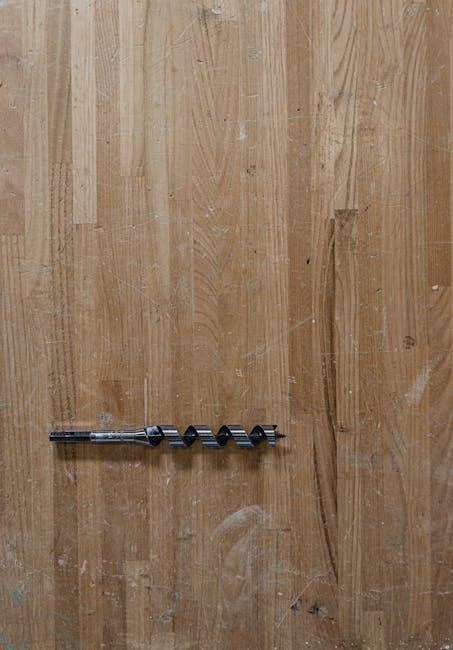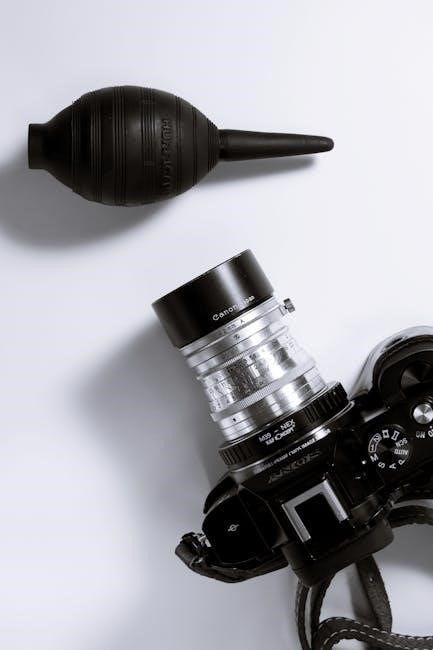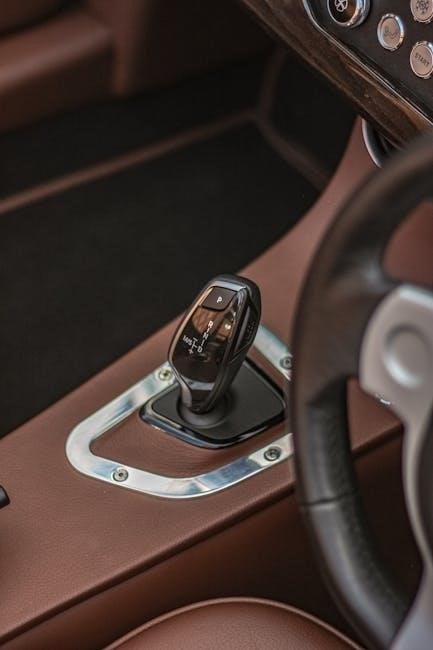A manual to automatic conversion kit is a specialized system designed to transform a vehicle’s manual transmission into an automatic one, offering ease of use and convenience.
These kits are tailored for drivers seeking smoother operation, reduced clutch pedal effort, and improved adaptability in various driving conditions, making them ideal for urban and long-distance commuting.
By integrating advanced components like torque converters and control modules, conversion kits provide a seamless transition, ensuring compatibility with modern vehicles and meeting the growing demand for automatic transmissions.
1.1 What is a Manual to Automatic Conversion Kit?
A manual to automatic conversion kit is a comprehensive set of components designed to transform a vehicle’s manual transmission system into an automatic one. It includes essential parts like torque converters, transmission control modules, and hydraulic systems. This kit enables vehicles to shift gears automatically, eliminating the need for manual clutch operation. It is a cost-effective solution for drivers seeking the convenience of an automatic transmission without purchasing a new vehicle.
1.2 Purpose and Functionality of the Conversion Kit
The purpose of a manual to automatic conversion kit is to provide a seamless and efficient way to switch from manual to automatic transmission. Its functionality revolves around components like the torque converter, which replaces the clutch, and the transmission control module, which manages gear shifts. The kit ensures smooth acceleration, reduces driver fatigue, and enhances overall driving comfort. It is particularly beneficial for urban driving, where frequent stops and starts are common, making it an ideal solution for modern commuting needs.
1.3 Overview of the Conversion Process
The conversion process involves replacing the manual transmission with an automatic system. It starts with preparing the vehicle by disconnecting essential components. The manual transmission is then disassembled and removed, followed by the installation of the automatic transmission, including the torque converter and control module. The wiring harness and hydraulic system are connected, and the transmission is calibrated to ensure proper function. Finally, the system is tested to verify smooth operation and reliability, completing the transition to an automatic setup.

Benefits of Converting from Manual to Automatic
Converting to automatic enhances driving comfort by eliminating manual shifting, reducing fatigue, and offering smoother acceleration. It simplifies urban driving and heavy traffic conditions.
2.1 Enhanced Driving Comfort and Convenience
Converting to an automatic transmission significantly enhances driving comfort by eliminating the need for manual shifting, reducing driver fatigue, and providing smoother acceleration.
This system allows drivers to focus more on the road, especially in heavy traffic or urban areas, where frequent gear changes are required.
The convenience of not having to operate a clutch pedal makes driving more enjoyable and accessible, particularly for those who prefer a more relaxed driving experience.
Automatic transmissions also reduce the physical effort required, making long drives less tiring and more comfortable overall.
2.2 Improved Traffic Handling and Reduced Fatigue
Automatic transmissions excel in heavy traffic conditions, eliminating the constant need for manual shifting and clutch operation, which significantly reduces driver fatigue.
This reduction in physical and mental effort allows drivers to remain more alert and focused on the road, enhancing overall safety and driving experience.
In stop-and-go situations, automatic transmissions smoothly handle acceleration and deceleration, minimizing the strain of frequent gear changes and making commuting more comfortable.
2.3 Better Suitability for Urban and Stop-and-Go Driving
Automatic transmissions are particularly advantageous in urban environments where frequent stops and starts are common.
They eliminate the need for constant clutch engagement and manual shifting, reducing wear on the vehicle and driver fatigue.
This makes automatics ideal for city driving, where smooth acceleration and seamless gear changes enhance comfort and maneuverability in tight traffic conditions.

Key Components of a Conversion Kit
A manual to automatic conversion kit includes essential parts like a torque converter, transmission control module (TCM), sensors, wiring harness, and hydraulic system for smooth operation.

3.1 Torque Converter and Its Role
The torque converter is a critical component that replaces the manual clutch, enabling smooth power transfer between the engine and automatic transmission. It uses fluid pressure to engage and disengage the engine from the transmission, eliminating manual clutch operation. The converter multiplies torque during acceleration, improving low-speed performance. Proper installation ensures seamless gear transitions, making it essential for the conversion’s success. Its design allows for automatic engagement, enhancing driving comfort and system efficiency.
3.2 Transmission Control Module (TCM)
The Transmission Control Module (TCM) is the brain of the automatic transmission system, responsible for controlling gear shifts, torque management, and overall transmission performance. It uses data from sensors to optimize shift points, ensuring smooth and efficient gear transitions. The TCM is pre-programmed to adapt to driving conditions, enhancing performance and fuel efficiency; Proper calibration of the TCM is essential for the conversion, as it ensures compatibility with the vehicle’s engine and drivetrain, making it a vital component for a successful manual-to-automatic conversion.
3.3 Sensors and Wiring Harness
Sensors and the wiring harness are critical for the automatic transmission system to function correctly. Sensors monitor vehicle speed, engine RPM, and transmission fluid temperature, providing real-time data to the TCM. The wiring harness connects these sensors to the TCM, ensuring accurate communication. Proper installation and calibration of the sensors and wiring are essential for smooth transmission operation; Any malfunction in this system can lead to incorrect gear shifts or transmission failure, making it vital to use high-quality components during the conversion process.
3.4 Hydraulic System and Pump
The hydraulic system and pump are essential for automatic transmission operation. The pump generates the pressure needed to engage gears and control clutch packs. The system includes valves, actuators, and fluid lines, working together to ensure smooth gear transitions. Proper installation and alignment of the hydraulic components are critical to avoid leaks or system failure. The pump’s performance directly impacts transmission efficiency, making it a vital part of the conversion process.

Step-by-Step Installation Guide
A detailed guide outlining the process, from preparing the vehicle to final testing, ensuring a smooth transition from manual to automatic transmission.
4.1 Preparing the Vehicle for Conversion
Begin by draining the manual transmission fluid and disconnecting the battery to ensure safety. Remove the gearshift and clutch pedal assembly, as they will no longer be needed. Secure the parking brake and raise the vehicle to access the transmission area. Inspect the transmission mounts and surrounding components for any damage or wear. Ensure all electrical connections are labeled before disconnection. Verify the vehicle’s compatibility with the conversion kit and gather all necessary tools and documentation. Proper preparation is key to a smooth conversion process.
4.2 Disassembling the Manual Transmission
Start by disconnecting the driveshaft and clutch assembly to access the manual transmission. Remove the transmission mounting bolts and gently pull the unit away from the engine. Disconnect the gear linkages and electrical connectors, ensuring they are labeled for reinstallation. Drain the transmission fluid into a pan to prevent spills. Use a socket set and wrenches to remove the transmission case bolts. Carefully lift the transmission out of the vehicle, taking note of any additional components that may need to be transferred to the automatic system.
4.3 Installing the Automatic Transmission System
Align the automatic transmission with the engine, ensuring proper fitment. Secure it using the provided mounts and bolts, tightening them evenly. Reconnect the driveshaft, making sure it is properly seated. Attach any necessary linkages or adapters for compatibility. Connect the hydraulic lines and electrical connectors to the transmission control module (TCM). Refill the transmission fluid as specified in the kit’s instructions. Double-check all connections for leaks or loose fittings before proceeding to the next step.
4.4 Connecting the Wiring and Hydraulic Systems
Connect the wiring harness to the transmission control module (TCM) and ensure all electrical connectors are securely attached. Link the throttle position sensor and speed sensor to the TCM for proper signal transmission. For the hydraulic system, attach the hydraulic lines to the pump and transmission, ensuring tight connections. Bleed the hydraulic system to remove air pockets and check for leaks. Finally, connect the fluid cooler lines and verify proper fluid flow before starting the engine for testing.
4.5 Testing and Calibration
After installation, perform a thorough powertrain test to ensure smooth operation. Start with a stationary test to check for leaks and proper hydraulic pressure. Gradually progress to road testing, assessing acceleration, shifting, and braking performance. Calibrate the TCM to optimize transmission behavior, ensuring seamless gear transitions. Monitor fluid temperature and pressure levels during operation. Address any irregularities promptly to prevent damage. Finalize by verifying all systems function as intended under various driving conditions.

Cost Analysis of the Conversion
The conversion kit costs between $1,500 to $3,000, depending on quality and brand. Labor fees for installation range from $1,000 to $2,500, totaling $2,500 to $5,500.
5.1 Initial Cost of the Conversion Kit
The initial cost of a manual to automatic conversion kit typically ranges from $1,500 to $3,000. This price varies based on the kit’s quality, brand, and included components. Basic kits may only include essential parts, while comprehensive kits might incorporate a torque converter, transmission control module, and wiring harness. Brand reputation and compatibility with specific vehicle models also influence the cost. It’s essential to research and compare different kits to find one that balances affordability with the necessary features for your vehicle.
5.2 Labor Costs for Professional Installation
Labor costs for professional installation of a manual to automatic conversion kit typically range between $1,000 and $2,500. These costs depend on the mechanic’s expertise, location, and the complexity of the job. Shops may charge hourly rates of $75 to $150, with the entire process taking 10 to 20 hours. More complex installations, such as those requiring custom wiring or additional modifications, may incur higher labor costs. Always confirm labor costs with the mechanic before proceeding.
5.3 Long-Term Cost Savings and Benefits
Converting to an automatic transmission offers long-term cost savings through improved fuel efficiency, especially in stop-and-go traffic. Reduced wear on brakes and clutch components lowers maintenance costs over time. Additionally, automatic transmissions often require less frequent repairs compared to manual systems. Enhanced resale value is another benefit, as automatic vehicles are generally more desirable to a broader audience. These factors make the conversion a financially viable option for many drivers.

Legal and Safety Considerations
Ensure compliance with local vehicle regulations and safety standards. Proper installation and testing are crucial to avoid legal issues and ensure safe operation of the converted vehicle.
6.1 Ensuring Compliance with Local Regulations
Before converting, verify that the modification complies with local vehicle codes and regulations. Obtain necessary approvals and certifications to ensure legality. Check if the conversion meets emissions and safety standards. Some jurisdictions may require inspections or documentation. Non-compliance can result in fines or legal penalties. Always consult local authorities to confirm specific requirements. Proper documentation and adherence to regulations ensure smooth approval and avoid future issues. Compliance is essential for legal operation of the converted vehicle.

6.2 Safety Precautions During the Conversion Process
Ensure a safe working environment when installing a manual to automatic conversion kit. Always wear protective gear, including gloves and safety glasses. Disconnect the battery to prevent accidental startups. Use proper tools and follow manufacturer guidelines. Work in a well-ventilated area, and avoid open flames near flammable materials. Never bypass safety protocols, and ensure the vehicle is securely supported with jack stands. Properly dispose of hazardous materials like transmission fluid. Keep a fire extinguisher nearby and avoid shortcuts to maintain safety throughout the process.
6.3 Liability and Insurance Implications
Converting a manual to automatic transmission may affect liability and insurance coverage. If the conversion leads to mechanical failure or an accident, the installer could be held liable. Insurance companies may deny claims if the conversion is not disclosed or approved. It’s crucial to inform your insurer about the modification to maintain coverage. Using non-approved kits can void warranties and insurance policies. Additionally, failing to disclose modifications when selling the vehicle can lead to legal consequences.

Maintenance and Care After Conversion
Regular maintenance ensures optimal performance. Check transmission fluid levels, inspect hoses, and monitor filter condition. Schedule periodic servicing to prevent wear and potential failures.
7.1 Regular Servicing Requirements
Regular servicing is essential to maintain the performance and longevity of the automatic transmission. Schedule bi-annual checks to inspect fluid levels, filter condition, and hydraulic system functionality. Ensure the transmission mounts are secure and the coolant system is functioning properly. Adhere to the manufacturer’s recommended service intervals to prevent premature wear. Address any unusual noises or performance issues promptly to avoid costly repairs. Consistent maintenance ensures smooth operation and extends the life of the conversion system.
7.2 Fluid Replacement and Filter Maintenance
Regular fluid replacement is critical for the automatic transmission’s health. Use the manufacturer-recommended ATF (Automatic Transmission Fluid) and replace it every 30,000 to 60,000 miles. The transmission filter should also be replaced during this interval to prevent debris buildup. Neglecting fluid and filter maintenance can lead to overheating, reduced performance, and premature wear on internal components. Always follow the manufacturer’s guidelines for fluid type and replacement intervals to ensure optimal transmission function and longevity.
7.3 Monitoring Transmission Performance
Monitoring the transmission’s performance is essential after the conversion. Keep an eye on shifting smoothness, unusual noises, or slipping gears. Check the transmission fluid level regularly and inspect for leaks. Use diagnostic tools to scan for error codes from the TCM. If the transmission hesitates or overheats, address the issue promptly. Regular check-ups ensure optimal performance and prevent major repairs. Early detection of problems helps maintain the reliability and efficiency of the automatic transmission system.

Troubleshooting Common Issues
Troubleshooting common issues after conversion involves identifying problems like erratic shifting or fluid leaks. Addressing these promptly ensures smooth operation and prevents further damage to the system.
8.1 Identifying and Diagnosing Problems
Identifying issues post-conversion involves checking for symptoms like slipping, hesitation, or warning lights. Use diagnostic tools to pinpoint faults in the torque converter or sensors. Inspect the wiring harness for loose connections and ensure proper fluid levels. Reviewing the installation process can reveal overlooked steps. Early detection of malfunctions prevents further damage and ensures optimal performance. Regular system checks are essential for maintaining reliability and efficiency after the conversion.
8.2 Common Errors During the Conversion Process
Common errors during the conversion include improper alignment of the torque converter, incorrect installation of the transmission control module, and faulty wiring connections. Issues like air in the hydraulic system or low fluid levels can also arise. Additionally, misconfigured sensors or improper calibration of the TCM may occur. These mistakes can lead to poor transmission performance or complete system failure. Careful adherence to instructions and double-checking each step can help minimize these errors and ensure a smooth conversion process.
8.3 Solutions for Post-Conversion Malfunctions
To address malfunctions after conversion, start by checking the torque converter for proper engagement and ensuring the transmission control module is calibrated correctly. Inspect the wiring harness for any loose connections or damage. Bleed the hydraulic system to remove air pockets and verify fluid levels. If issues persist, recheck sensor alignments and consult the manufacturer’s troubleshooting guide. Professional assistance may be needed for complex problems, ensuring the system operates smoothly and efficiently after repairs.
Converting a manual to automatic enhances driving comfort, reduces fatigue, and offers convenience, especially in urban settings. It’s a worthwhile investment for long-term benefits and hassle-free driving.
9.1 Final Thoughts on the Conversion Process
Converting a manual to automatic transmission offers significant benefits, including enhanced comfort, reduced fatigue, and improved suitability for urban driving. While the process requires careful planning and expertise, the long-term advantages often outweigh the initial costs. Proper installation and maintenance are crucial for optimal performance. Whether for convenience or practicality, this conversion can be a worthwhile investment for drivers seeking a smoother, more modern driving experience. It’s essential to weigh personal needs and budget before deciding.
9.2 Is the Conversion Worth the Investment?
Whether the conversion is worth the investment depends on individual needs and preferences. For those prioritizing convenience, reduced fatigue, and smoother urban driving, it can be a valuable upgrade. The initial cost may seem high, but long-term benefits like lower maintenance and potential fuel efficiency improvements can offset expenses. Additionally, it enhances resale value for vehicles in demand for automatic transmissions. Ultimately, it’s a practical choice for drivers seeking modernized comfort and performance.
